Final ATSB report reveals safety failures before tragic 2023 Gold Coast Sea World helicopter crash
The cause of the tragic Sea World helicopter crash that killed four people has been revealed, with the transport watchdog flagging serious safety failures.
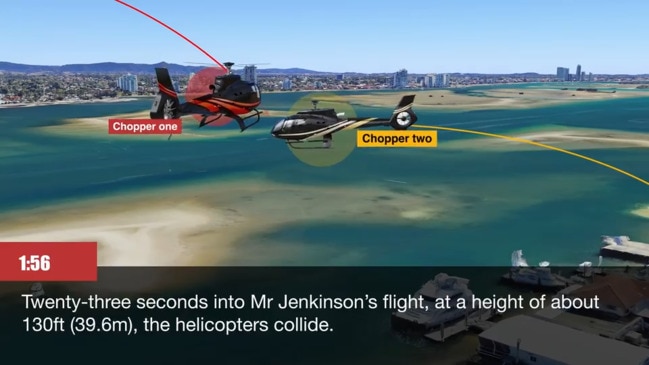
Breaking News
Don't miss out on the headlines from Breaking News. Followed categories will be added to My News.
A set of serious safety gaps from tourism operator Sea World Helicopters preceded the tragic Gold Coast helicopter crash that claimed the lives of four people, the nation’s transport safety watchdog has found.
In its final report into the January 2023 crash, the Australian Transport Safety Bureau (ATSB) said Sea World Helicopters had made changes to its location, facilities and helicopters to improve its product offering and those changes had brought “unintended consequences”.
Specifically, the system in place intended to warn pilots of the presence of another helicopter was “flawed”, the ATSB found, leading to both pilots not having an accurate understanding of where the other was.
The tragedy unfolded on a bright and sunny day on the Gold Coast on January 2, 2023, just before 2pm.
Eleven tourists packed into two Eurocopter EC130 helicopters for a scenic tour of the Gold Coast strip.
The choppers, operating from two separate but close-by helipads, crashed as one was ascending into the air while the other was coming in to land.
Four people died in the helicopter that was taking off.
The tail and main rotor of the chopper were separated in the crash and it quickly plunged into a sandbank.
Pilot Ashley Jenkinson was killed along with Sydney mum Vanessa Tadros and British couple Diane and Ronald Hughes.
Ms Tadros’s son Nicholas was seriously injured in the crash, alongside Victorian mum Winnie De Silva and her son Leon.
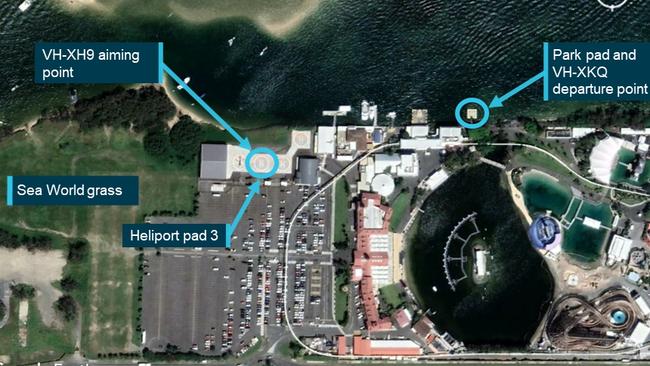
The returning chopper was piloted by Michael James.
He managed to land the badly damaged helicopter on the sand, despite the chopper suffering serious damage.
Mr James was seriously injured in the event.
Five passengers in his chopper were injured, two of them seriously.
The pilots were conducting the flights concurrently from two nearby helipads, the report found, and the position of the two pads so close to each other had created a “conflict point”.
“Limitations in visibility from both helicopters and especially VH‑XKQ (the departing chopper), combined with competing priorities and an understanding that the airspace was clear, led to a midair collision as both helicopters were passing through the conflict point created by the positioning of the helipads,” the report found.
“The operator’s procedures for scenic flights were not wholly specific to their operation and introduced variability in pilot decision‑making and conduct of the scenic flights.
“Additionally, the operator’s system of radio calls, hand signals and conspicuity devices, intended to warn pilots of the presence of another helicopter, was flawed.
“As a result, both pilots formed an incorrect understanding about the location of the other helicopter.”
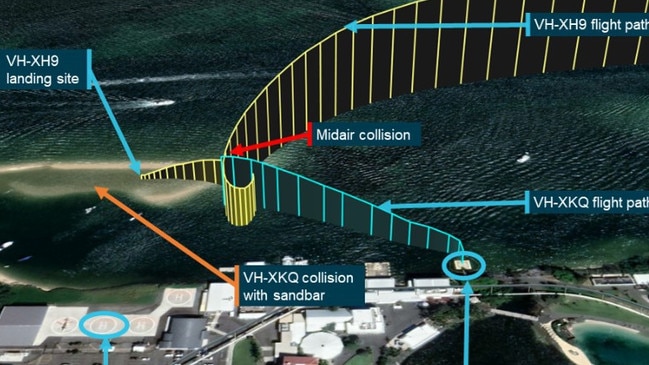
The mammoth report details multiple safety failures, though the watchdog stresses the “findings should not be read as apportioning blame or liability to any particular organisation or individual”.
For one, the report found safety gaps in ground crew procedures.
“Sea World Helicopters’ procedure did not require ground crew to monitor the airspace up to the time of the helicopter departing the helipad,” the report finds.
“As the presence of hazards behind the helicopter could change significantly within a short space of time, helicopters routinely departed without current hazard information from ground crew.”
Reopening the park helipad in March 2022 created an increased risk of collision with traffic from the existing helipad, the report states.
“There was a higher workload for both pilots – both pilots needed to consider the effect of helicopter downwash on surface traffic, it was less likely that an inbound pilot would notice a change in the status of a helicopter on the ground, it was more difficult for an outbound pilot to acquire traffic (and) helicopters would close on each other vertically and laterally, decreasing likelihood of detection,” the report found.
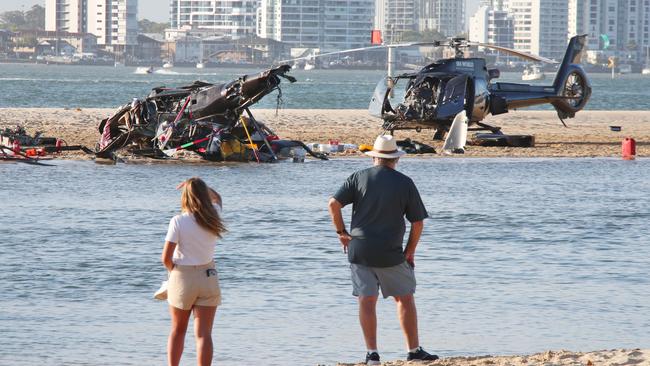
Flaws in communication were also a key factor, the ATSB found.
“Following the change in ownership of Sea World Helicopters, changes to the operation gradually degraded existing controls of enhanced communication and in-cockpit traffic display that informed team situation awareness and the controls were eventually withheld without formal analysis of the change,” the report found.
“This reduced opportunity for company pilots to form and maintain awareness of each other’s position and intentions.”
ATSB chief commissioner and chief executive Angus Mitchell, speaking at a press conference on Wednesday, said that about two minutes before the collision, an inbound call from the landing helicopter failed to register with the departing pilot, who was busy loading passengers at the time.
Once passenger loading was complete, a member of the ground crew advised the departing pilot that the airspace was clear, but this was outdated by the time the helicopter took off 20 seconds later.
He said the inbound helicopter was now much closer to the collision point and its pilot had not received a call indicating the second chopper was about to take off.
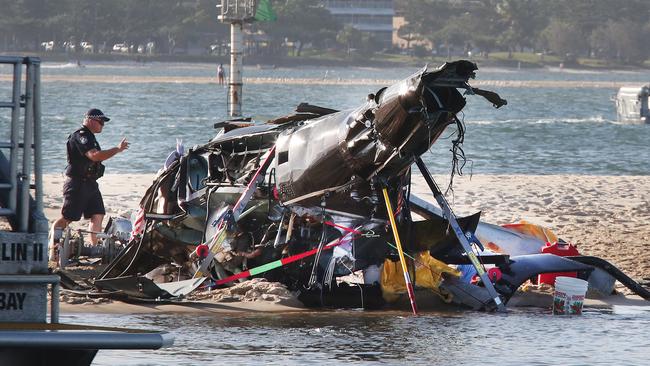
“Failure to receive this call – which video evidence suggests was made by the departing pilot – was most likely due to faults the ATSB found in the departing helicopter’s radio antenna,” Mr Mitchell said.
He said the new helicopters were not equipped with internal company radios, iPads with maps showing real-time positions of other aircraft, or high-visibility paint on all rotor blades.
“Most importantly, the introduction of the second helipad nine months earlier created a constant and defined conflict point between launching and landing helicopters,” Mr Mitchell said.
“A point in which ultimately – and tragically – the two helicopters collided.”
In a statement on Wednesday, Sea World Helicopters thanked the ATSB for its investigation.
“It is critical that industry benefits from any lessons that can be learned,” the company said.
“The accident occurred within a compliant and professionally managed organisation, which exceeded the minimum regulatory requirements of the general aviation sector.
“Our company maintains robust safety systems, dedicated support staff and rigorous oversight protocols to uphold the highest standards of aviation safety.
“We remain committed to consistently evolving our safety measures. We acknowledge the ATSB’s specific recommendations and will respond within the allocated time-frame.”
Shine Lawyers has filed a claim against Sea World Helicopters at the Queensland Supreme Court.
“I can confirm Shine Lawyers has filed a number of claims in the Supreme Court of Queensland on behalf of several people who were injured on board one of the helicopters, as well as others who were indelibly traumatised by what they witnessed on that day,” Shine national litigation specialist Roger Singh said on Wednesday.

“These claims have been filed against Sea World Helicopters Pty Ltd.
“The claims for the passengers of the helicopter have been filed under the Civil Aviation Act, which caps damages at $925,000 per claimant.
“We will examine the findings of this report with a view to identifying other potential defendants and further damages which may be sought.”
Mr Mitchell said the investigation had also sought to understand why some passengers had survived while others had perished.
“Our investigation found that passenger seat belts were incorrectly fitted,” he said.
“This evidence was primarily gathered through mobile phone footage and consistent with what we discovered internationally with other aviation tourism operations.
“While the ATSB was unable to determine the extent to which the incorrectly fitted seat belts contributed to passenger injuries, primarily as so many forces come into play in an accident of this nature, we know that correctly fitted restraints improve survivability for passengers.”
Mr Mitchell used the analogy of a “Swiss cheese model” to explain the tragedy.
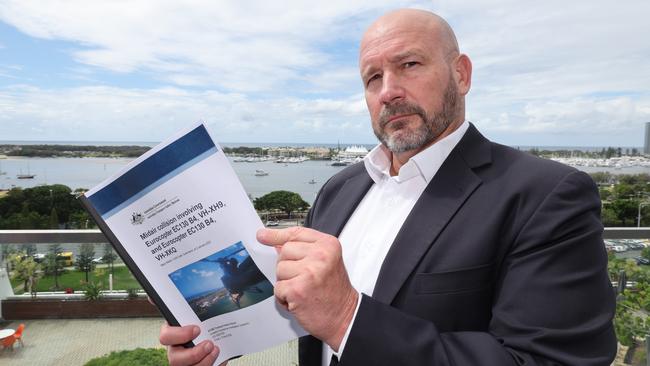
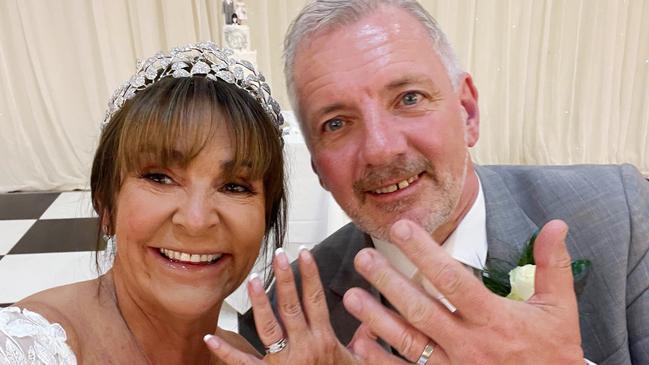
“You need a number of those holes to all line up at the same period of time for this outcome to occur,” he said.
“Commercial aviation should have multiple defences in place, so when one thing goes wrong – such as a faulty radio … or a pilot not visually detecting another aircraft, or not hearing a call – that doesn’t all line up together.
“A lot of the holes that we found that lined up back on January 2, 2023 have been addressed by the company.
“But, as I’ve said, we do believe that there is some more work that needs to be done, and that’s more so looking into the future to make sure that, when changes occur in aviation operations – not just to this company, but to any operator – that they’re very carefully considered as to how they impact other parts of the business and other parts of the operation.”
Mr Mitchell confirmed there would be a coronial inquest into the deaths.
“The ATSB’s investigation is now complete and we are a no-blame investigator, so we are focused on, one understanding the sequence of events, which we have done to a great extent here, and two – what can be done to improve it,” he said.
“There certainly will be a coronial into this. Whether there are any other types of proceedings, they’re separate to the ATSB.”
Originally published as Final ATSB report reveals safety failures before tragic 2023 Gold Coast Sea World helicopter crash



